Do Covid-19 “vaccines” give people AIDS? The immune system drops by ca. 5% every week in those who have been vaccinated
Frontline News and additions made by Robert Gorter, MD, PhD.
October 18, 2021
Dr. Robert Gorter: already in May 2020, we have postulated that the large sequences of HIV found in the COVID-19 virus / Wuhan virus was a product of “Gain-of-Function” and would cause immunodeficiencies, similarly found in HIV infection, leading to AIDS. It is therefore no surprise to us that not only quite a few people, who had COVID-19 infection recover slowly and/or keep having symptoms and poor recovery.
As part of this article, we will pay attention to the findings of Luc de Montagnier, who received the Nobel Prize for discovering HIV and who documented very clearly and convincingly the presence of large sequences of HIV (and of the malaria parasite).
Other researchers found independently exactly the same sequences (see later in this article).
Thus, it comes as no surprise to read these observations as described by The Exposé / the UK’s PHE Vaccine Surveillance Report that mRNA-containing vaccines accelerate the development of AIDS-like immunosuppression.
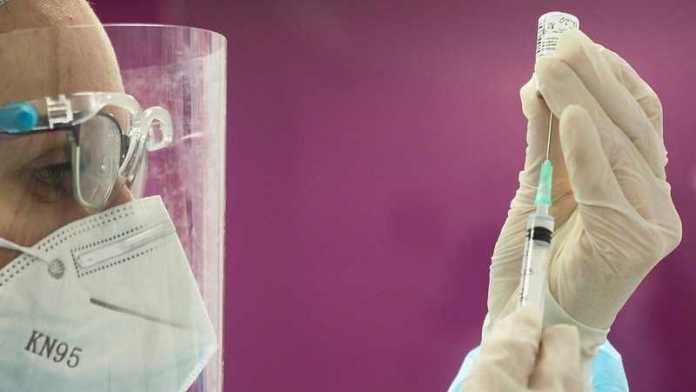
The latest data from the UK’s PHE Vaccine Surveillance Report shows that people who are “fully vaccinated” against the Wuhan coronavirus (Covid-19) lose about five percent of their immune systems per week, reports Ethan Huff.
Double-injected people between the ages of 40 and 70 have already lost about 40 percent of their immune system capacity from the moment they are injected. Over time, they gradually lose more of them, with many expecting the peak of immune system loss by Christmas, 2021.
“If this continues, 30-50-year-olds will have 100% immune breakdown, zero viral defenses by Christmas, 2021 and all doubly vaccinated people over 30 will have lost their immune systems by March next year,” reports The Exposé.
Based on the data, there is no denying that fully vaccinated people now suffer from what appears to be acquired immunodeficiency syndrome, more popularly known as AIDS. Their immune systems are fading, something many have warned about.
“People between the ages of 40 and 69 have already lost 40% of their immune system and are gradually losing it at a rate of 3.3% to 6.4% per week,” said The Exposé.
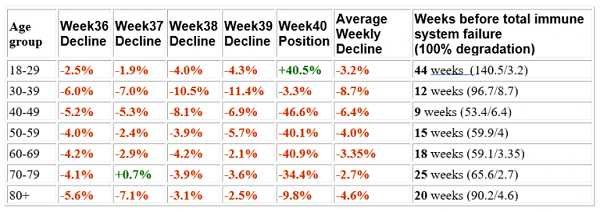
Interestingly, the worst-affected population consists of people between the ages of 40 and 49, who have a total loss of their immune system in about nine weeks. The “best” affected group were the young people between the ages of 18 and 29, who last about 44 weeks.
Older people over 80 last about 20 weeks, while the 50-59 age group only gets about 15 weeks. The other age groups last between 12 and 25 weeks.
“Anyone over 30 will have lost 100% of their entire immune system (against viruses and certain cancers) within 6 months,” warns The Exposé.
“30-50-year-olds will have lost it all by Christmas 2021. These people will then effectively have a fully acquired immunodeficiency syndrome and destroy the NHS (National Health Service).”
Taking a “booster” injection will only speed up the death process
It’s not just that the shots don’t offer the claimed protection against the Covid cold/flu virus. The fact is that in the long run, they provide no protection at all and basically destroy a person’s immune system.
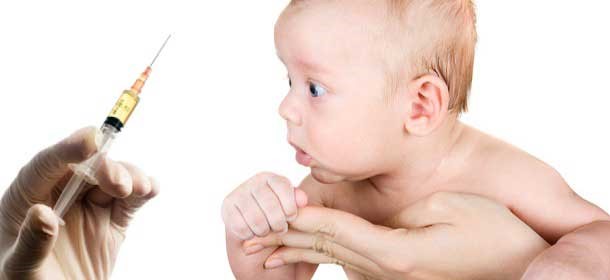
“Pfizer originally claimed 95% efficiency for their vaccine (calculated as in the last column above). The numbers above indicate that their numbers may have been correct immediately after vaccination (the younger age groups have had the vaccine the shortest),” explains The Exposé.
“But the numbers above also show that the vaccines do NOT just lose efficiency over time to zero efficiencies, but that they progressively damage the immune system until negative efficiency is reached. They are currently leaving anyone over 30 in a worse position than they were before the vaccine.”
People taking the “Booster” injections will only speed up this process by adding even more immune-destroying chemicals to their bodies. The downward spiral will be even faster, in other words, the more vaccinations someone gets.
“If we don’t do something about this, it will only get much worse than we could ever have imagined. I appreciate everyone who has resisted and continues to resist this tyranny,” wrote one Exposé commentator.
“The spike protein hijacks your mitochondria… forever. Mitochondria are the heart of the antibody production your immune system. Essentially, it takes over your immune system. The spike proteins are the bioweapons. Your own immune system becomes a deadly weapon. This is HIV on steroids,” wrote another.
Others joined in, noting that it is painfully clear what the agenda is. How anyone with a straight face can claim that this is all for “public health” remains a mystery.
![]()
A comparison of official Government reports suggest the Fully Vaccinated are developing Acquired Immunodeficiency Syndrome
By
The Expose on October 10th, 2021.
Latest UK PHE Vaccine Surveillance Report figures on Covid cases show that doubly vaccinated 40-70-year-olds have lost 40% of their immune system capability compared to unvaccinated people. Their immune systems are deteriorating at around 5% per week (between 2.7% and 8.7%). If this continues then 30-50-year-olds will have 100% immune system degradation, zero viral defense by Christmas 2021 and all doubly vaccinated people over 30 years will have lost their immune systems by March next 2022.
The 5 PHE tables below from their excellent Vaccine Surveillance Report, separated by 4 weeks, clearly show the progressive damage that the vaccines are doing to the immune system’s response in general (against viral and bacterial infections; and against cancer cells.
People aged 40-69 have already lost 40% of their immune system capability and are losing it progressively at 3.3% to 6.4% per week.
Weekly Decline in doubly vaccinated immune system performance compared to unvaccinated people…
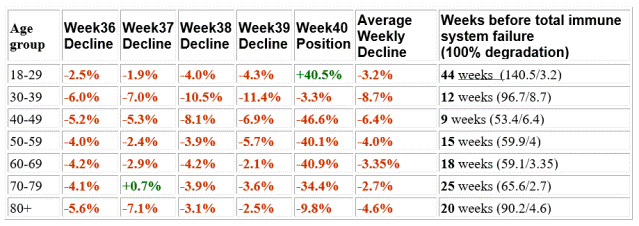
Everybody over 30 years of age will have lost 100% of their entire immune capability (for viruses and certain cancers) within 6 months.
30-50-year-olds will have lost it by Christmas. These people will then effectively have full-blown acquired immunodeficiency syndrome and destroy the NHS.
The vaccine booster shots have to be the same as the vaccines themselves because it takes forever to do clinical trials and get approval for something different. So if you take a booster shot, these figures show that you are giving yourself an even faster progressive form of acquired immunodeficiency syndrome (after a couple of months of effectiveness).
Table 2. COVID-19 cases by vaccination status…
Cases reported by specimen date between week 32 and week 35 2021 – https://assets.publishing.service.gov.uk/government/uploads/system/uploads/attachment_data/file/1016465/Vaccine_surveillance_report_-_week_36.pdf
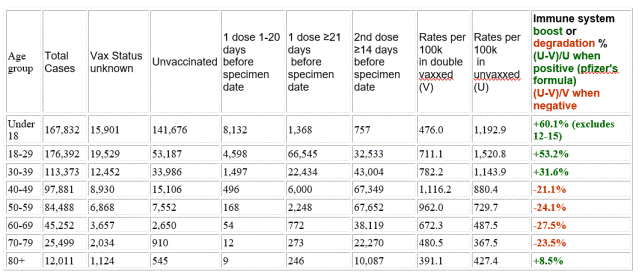
Cases reported by specimen date between week 33 and week 36, 2021 – https://assets.publishing.service.gov.uk/government/uploads/system/uploads/attachment_data/file/1018416/Vaccine_surveillance_report_-_week_37_v2.pdf
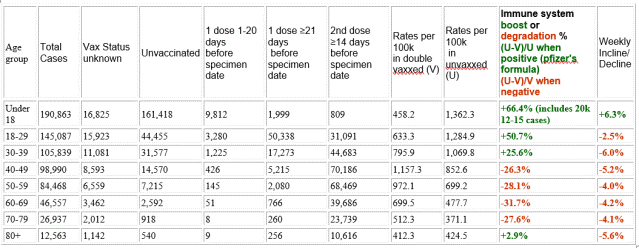
Cases reported by specimen date between week 34 and week 37, 2021 – https://assets.publishing.service.gov.uk/government/uploads/system/uploads/attachment_data/file/1019992/Vaccine_surveillance_report_-_week_38.pdf
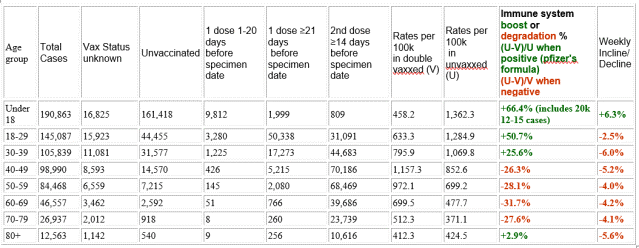
Cases reported by specimen date between week 35 and week 38, 2021 – https://assets.publishing.service.gov.uk/government/uploads/system/uploads/attachment_data/file/1022238/Vaccine_surveillance_report_-_week_39.pd

Cases reported by specimen date between week 36 and week 39 2021
Pfizer originally claimed an approx. 95% efficiency for their vaccine (calculated as in the last column above). The figures above indicate that their figures may well have been correct immediately after vaccination (the younger age groups have had the vaccine for the shortest time).
But the figures above also show that the vaccines do NOT merely lose efficiency over time down to zero efficiencies, they progressively damage the immune system until a negative efficiency is realized. They presently leave anybody over age 30 in a worse position than they were before vaccination.
Uncanny similarity of unique inserts in the 2019-nCoV spike protein to HIV-1 gp120 and Gag:
Created by Gain-of-Function (for Bio Warfare)
by
Prashant Pradhan, Ashutosh Kumar Pandey, Akhilesh Mishra, Parul Gupta, Praveen Kumar Tripathi, Manoj Balakrishnan Menon, James Gomes, Perumal Vivekanandan, Bishwajit Kundu
DOI: https://doi.org/10.1101/2020.01.30.927871 / 13501013714698 Posted January 31, 2020.
Abstract
We are currently witnessing a major epidemic caused by the 2019 novel coronavirus (2019-nCoV). The evolution of 2019-nCoV remains elusive. We found 4 insertions in the spike glycoprotein (S) which are unique to the 2019-now and are not present in other coronaviruses. Importantly, amino acid residues in all 4 inserts have the same identity or strong similarity to those in the HIV-1 gp120 or HIV-1 Gag. Interestingly, despite the inserts being discontinuous on the primary amino acid sequence, 3D-modelling of the 2019-nCoV strongly suggests that they converge to constitute the receptor binding site. The finding of these 4 unique inserts in the 2019-nCoV, all of which have identity /similarity to amino acid residues in key structural proteins of HIV-1 is unlikely to be fortuitous in nature. This work provides yet unknown insights on 2019-nCoV and sheds light on the evolution and pathogenicity of this virus with important implications for the diagnosis of this virus.
These findings lead to the conclusion that 2019-nCoV (SARS-CoV-2) has been created in a laboratory as such a chunk of HIV-1 cannot have occurred as a natural and spontaneous mutation.
References
↵Beniac, D. R., Andonov, A., Grudeski, E., & Booth, T. F. (2006). The architecture of the SARS coronavirus prefusion spike. Nature Structural and Molecular Biology, 13(8), 751–752. https://doi.org/10.1038/nsmb1123Google Scholar
↵Biasini, M., Bienert, S., Waterhouse, A., Arnold, K., Studer, G., Schmidt, T., Kiefer, F., Cassarino, T. G., Bertoni, M., Bordoli, L., & Schwede, T. (2014). SWISS-MODEL: Modelling protein tertiary and quaternary structure using evolutionary information. Nucleic Acids Research. https://doi.org/10.1093/nar/gku340Google Scholar
↵Bosch, B. J., van der Zee, R., de Haan, C. A. M., & Rottier, P. J. M. (2003). The Coronavirus Spike Protein Is a Class I Virus Fusion Protein: Structural and Functional Characterization of the Fusion Core Complex. Journal of Virology, 77(16), 8801–8811. https://doi.org/10.1128/jvi.77.16.8801-8811.2003Abstract/FREE Full TextGoogle Scholar
↵Chan, J. F.-W., Kok, K.-H., Zhu, Z., Chu, H., To, K. K.-W., Yuan, S., & Yuen, K.-Y. (2020). Genomic characterization of the 2019 novel human-pathogenic coronavirus isolated from a patient with atypical pneumonia after visiting Wuhan. Emerging Microbes & Infections, 9(1), 221–236. https://doi.org/10.1080/22221751.2020.1719902Google Scholar
↵Chan, J. F. W., Lau, S. K. P., To, K. K. W., Cheng, V. C. C., Woo, P. C. Y., & Yuen, K.-Y. (2015). Middle East Respiratory Syndrome Coronavirus: Another Zoonotic Betacoronavirus Causing SARS-Like Disease. https://doi.org/10.1128/CMR.00102-14Google Scholar
↵Chan, J., To, K., Tse, H., Jin, D., microbiology, K. Y.-T. in, & 2013, undefined. (n.d.). Interspecies transmission and emergence of novel viruses: lessons from bats and birds. Elsevier.Google Scholar
↵Corpet, F. (1988). Multiple sequence alignment with hierarchical clustering. Nucleic Acids Research. https://doi.org/10.1093/nar/16.22.10881Google Scholar
↵DeLano, W. L. (2002). The PyMOL Molecular Graphics System, Version 1.1. Schr{ö}dinger LLC. https://doi.org/10.1038/hr.2014.17Google Scholar
↵Du, L., Zhao, G., Kou, Z., Ma, C., Sun, S., Poon, V. K. M., Lu, L., Wang, L., Debnath, A. K., Zheng, B.-J., Zhou, Y., & Jiang, S. (2013). Identification of a Receptor-Binding Domain in the S Protein of the Novel Human Coronavirus Middle East Respiratory Syndrome Coronavirus as an Essential Target for Vaccine Development. Journal of Virology, 87(17), 9939–9942. https://doi.org/10.1128/jvi.01048-13Abstract/FREE Full TextGoogle Scholar
↵Edgar, R. C. (2004). MUSCLE: Multiple sequence alignment with high accuracy and high throughput. Nucleic Acids Research. https://doi.org/10.1093/nar/gkh340Google Scholar
↵Elbe, S., & Buckland-Merrett, G. (2017). Data, disease and diplomacy: GISAID’s innovative contribution to global health. Global Challenges. https://doi.org/10.1002/gch2.1018Google Scholar
↵Kirchdoerfer, R. N., Cottrell, C. A., Wang, N., Pallesen, J., Yassine, H. M., Turner, H. L., Corbett, K. S., Graham, B. S., McLellan, J. S., & Ward, A. B. (2016). Pre-fusion structure of a human coronavirus spike protein. Nature. https://doi.org/10.1038/nature17200Google Scholar
↵Kumar, S., Stecher, G., Li, M., Knyaz, C., & Tamura, K. (2018). MEGA X: Molecular evolutionary genetics analysis across computing platforms. Molecular Biology and Evolution. https://doi.org/10.1093/molbev/msy096Google Scholar
↵Li, F. (2016). Structure, Function, and Evolution of Coronavirus Spike Proteins. Annual Review of Virology, 3(1), 237–261. https://doi.org/10.1146/annurev-virology-110615-042301Google Scholar
↵Murakami, T. (2008). Roles of the interactions between Env and Gag proteins in the HIV-1 replication cycle. Microbiology and Immunology, 52(5), 287–295. https://doi.org/10.1111/j.1348-0421.2008.00008.xCrossRefPubMedGoogle Scholar
↵Ou, X., Guan, H., Qin, B., Mu, Z., Wojdyla, J. A., Wang, M., Dominguez, S. R., Qian, Z., & Cui, S. (2017). Crystal structure of the receptor binding domain of the spike glycoprotein of human betacoronavirus HKU1. Nature Communications. https://doi.org/10.1038/ncomms15216Google Scholar
↵Snijder, E. J., van der Meer, Y., Zevenhoven-Dobbe, J., Onderwater, J. J. M., van der Meulen, J., Koerten, H. K., & Mommaas, A. M. (2006). Ultrastructure and origin of membrane vesicles associated with the severe acute respiratory syndrome coronavirus replication complex. Journal of Virology, 80(12), 5927–5940. https://doi.org/10.1128/JVI.02501-05Abstract/FREE Full TextGoogle Scholar
↵Zhou, P., Yang, X.-L., Wang, X.-G., Hu, B., Zhang, L., Zhang, W., Si, H.-R., Zhu, Y., Li, B., Huang, C.-L., Chen, H.-D., Chen, J., Luo, Y., Guo, H., Jiang, R.-D., Liu, M.-Q., Chen, Y., Shen, X.-R., Wang, X., … Shi, Z.-L. (2020). Discovery of a novel coronavirus associated with the recent pneumonia outbreak in humans and its potential bat origin. BioRxiv. https://doi.org/10.1101/2020.01.22.914952Google Scholar
↵Zhu, N., Zhang, D., Wang, W., Li, X., Yang, B., Song, J., Zhao, X., Huang, B., Shi, W., Lu, R., Niu, P., Zhan, F., Ma, X., Wang, D., Xu, W., Wu, G., Gao, G. F., & Tan, W. (2020). A Novel Coronavirus from Patients with Pneumonia in China, 2019. New England Journal of Medicine, NEJMoa2001017. https://doi.org/10.1056/NEJMoa2001017Google Scholar
COVID-19, SARS and Bats Coronaviruses Genomes Unexpected Exogenous RNA Sequences
by
Jean Claude Perez and Luc Montagnier
DOI: 10.31219/osf.io/tgw2d
This video is a thorough investigation into the (wrong-)doings of all those who drive the SARS-CoV-2 epidemic. The languages used in this video are several but predominantly German and English.
This video is clearly exposed the vicious attempts by Big Pharma and their serving politicians and “scientists” to silence World Leading experts in the field, like the French virologist Luc Montagnier who received the Novel Prize in 2008 for his discovery of HIV.

Luc Montagnier who received the Nobel Prize for his discovery of HIV in 2008
Description
We are facing the worldwide invasion of a new coronavirus. This follows several limited outbreaks of related viruses in various locations in the recent past (SARS, MERS). Although the main objective of researchers is to bring efficient therapeutic and preventive solutions to the global population, we need also to better understand the origin of the newly coronavirus-induced epidemic in order to avoid future outbreaks. The present molecular appraisal is to study by a bio-informatic approach the facts relating to the virus and its precursors. This article shows how 16 fragments (Env Pol and Integrase genes) from different strains, both diversified and very recent, of the HIV-1, HIV-2, and SIV retroviruses most likely are present in the genome of COVID-19 (SARS-CoV-2). Among these fragments, 12 are concentrated in a very small region of the COVID-19 genome, length less than 900bases, i.e. less than 3% of the total length of this genome. In addition, these footprints are positioned in 2 functional genes of COVID-19: the orf1ab and S spike genes. To sum up, here are the two main facts which contribute to our hypothesis of a partially synthetic genome: A contiguous region representing 2.49% of the whole COVID-19 genome of which 40.99% is made up of 12 diverse fragments originating from various strains of HIV-1 and HIV-2 and SIV retroviruses. On the other hand, these 12 fragments some of which appear concatenated. Notably, the retroviral part of these regions, which consists of 8 elements from various strains HIV-1, HIV-2, and SIV covers a length of 275 contiguous bases of COVID-19. The cumulative length of these 8 HIV SIV elements represents 200 bases. Consequently, the HIV SIV density rate of this region of COVID-19 is 200/275 = 72.73%, which is considerable s made of. Moreover, each of these elements is made of 18 or more nucleotides and therefore may have a function. They are called Exogenous Informative Elements. A major part of these 16 EIE already existed in the first SARS genomes as early as 2003. However, we demonstrate how and why a new region including 4 HIV-1 HIV-2 Exogenous Informative Elements radically distinguishes all COVID-19 strains from all SARS and Bat strains. We then gather facts about the possible origins of COVID-19. We have particularly analyzed this small region of 225 bases common to COVID-19 and batRaTG13 but totally absent in all SARS strains. Then, we discuss the case of bat genomes presumed to be at the origin of COVID_19. In the strain of bat RaTG13 coronavirus isolated in 2013, then sequenced in 2020, the homology profile for HIV-1 Kenya 2008 fragment is identical to that of COVID-19. Finally, we have studied the most recent genetic evolution of the COVID-19 strains involved in the world epidemic. We found a significant occurrence of mutations and deletions in the 225b region. On sampling genomes, we finally show that this 225b key region of each genome, rich in EIE, evolves much faster than the corresponding whole genome. The comparative analysis of the SPIKES genes of COVID_19 and Bat RaTG13 demonstrates two abnormal facts: on the one hand, the insertion of 4 contiguous amino acids in the middle of SPIKE, on the other hand, an abnormal distribution of synonymous codons in the second half of SPIKE. Finally, the insertion in this region of an EIE coming from a Plasmodium yoelii gene is demonstrated, but above all seems to explain the “strategy” pursued by having “artificially” modified the ratio of synonym codons / non-synonymous codons in this same region of 1770 COVID-19 SPIKE nucleotides.
Im sorry but the Weekly Decline in doubly vaccinated immune system performance compared to unvaccinated people report is not factual, none of the links in PHE show this. Having articles with this type of information will discredit you.